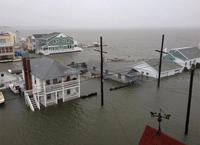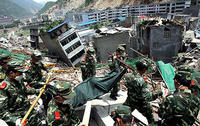-
U.S. faces more – and more intense – wildfire

Scientists using NASA satellite data and climate models have projected drier conditions likely will cause increased fire activity across the United States in coming decades; the researchers calculated results for low and high greenhouse gas emissions scenarios; in both cases, results suggest more fire seasons that are longer and stronger across all regions of the United States in the next 30-50 years; specifically, high fire years like 2012 would likely occur two to four times per decade by mid-century, instead of once per decade under current climate conditions
-
-
Geoengineering could disrupt global rainfall patterns
Tackling climate change by reducing the solar radiation reaching our planet using climate engineering, known also as geoengineering, could result in undesirable effects for the Earth and humankind; in particular, new research shows that disruption of global and regional rainfall patterns is likely in a geoengineered climate
-
-
TVA considering raising height of dams to prevent future floods
The dams located on the upper Tennessee River never had flood waters top them, and government officials want to keep it that way, saying that due to recent disasters such as the 2010 Nashville flood and the 2011Fukushima tsunami, they need to prepare the worst possible situation
-
-
Removing sea defenses may reduce impact of coastal flooding
Coastal defenses put in place over the last century or so have re-shaped the U.K. coastline, artificially protecting some areas, but at the expense of beaches in adjacent areas; this man-made situation increases the risk of flooding in low lying coastal settlements where beaches act as a natural flood defense; beach levels can be artificially recharged, but maintaining this indefinitely along large stretches of coastline is costly and likely to be unsustainable
-
-
World’s first hazard scale for wildland fires created
Two federal agencies have teamed to create the first-ever system for linking accurate assessments of risk from wildland fires to improved building codes, standards and practices that will help communities better resist the threat; the proposed Wildland Urban Interface (WUI) Hazard Scale addresses fires that occur where developed and undeveloped areas meet
-
-
Andrew Cuomo heads to Washington to push for disaster aid
Governor Andrew Cuomo says that New York needs $33 billion to cover storm cleanup and another $9 billion for new programs to protect against future storms; Governor Chris Christie of New Jersey says his state will need $36.8 billion to recover from Sandy; it is not clear how Congress and the administration, locked in a tug of war over differing deficit cut plans, will respond
-
-
Himalayas, Pacific Northwest could experience major earthquakes
Research by Stanford scientists focuses on geologic features and activity in the Himalayas and Pacific Northwest that could mean those areas are primed for major earthquakes
-
-
Responding to future oil spills: lessons learned from Deepwater Horizon
A special collection of articles about the Deepwater Horizon oil spill provides the first comprehensive analysis and synthesis of the science used in the unprecedented response effort by the government, academia, and industry;with the benefit of hindsight and additional analyses, these papers evaluate the accuracy of the information that was used in real-time to inform the response team and the public
-
-
Below Russian Far East there is a seismic hazards that could threaten Pacific Basin
For decades, a source of powerful earthquakes and volcanic activity on the Pacific Rim was shrouded in secrecy, as the Soviet government kept outsiders away from what is now referred to as the Russian Far East; research in the last twenty years, however, has shown that the Kamchatka Peninsula and Kuril Islands are a seismic and volcanic hotbed, with a potential to trigger tsunamis that pose a risk to the rest of the Pacific Basin
-
-
Public safety networks coped better with Sandy than commercial networks
A new nationwide Long Term Evolution (LTE) network for first responders will be built under the supervision of the First Responder Authority (FirstNet); this network will be an improvement over the commercial networks that experienced outages during Hurricane Sandy
-
-
Post-Sandy insurance rates increase may make coastal living unaffordable

Residents of New York and New Jersey are still coping with the destruction Hurricane Sandy caused, but home and business owners alike will soon face another burden: rising insurance rates and new building codes and requirements that could threaten many that live and work in the coastal areas of the two states
-
-
Lloyd’s says countries are under insured against natural disasters

Lloyd’s of London, the world’s largest insurance company, has warned seventeen countries that a $165 billion global insurance deficit leaves them vulnerable to long-term natural disaster costs; Lloyds says the world may not be able to afford another year like 2011, when natural disasters such as the earthquake and tsunami in Japan and the floods in Thailand caused $4.6 trillion dollars of damage to infrastructure, homes, and businesses, and which resulted in the largest disaster claims ever
-
-
The debate over radon as an earthquake predictor continues
Scientists have been interested in using radon emissions to predict earthquakes since the 1980s, but no solid evidence ever came to support it and the idea was abandoned by most in the field during the 1990s; now, scientists are looking again at radon as an earthquake predictor
-
-
Hard choices to be made on adapting infrastructure to climate change
The costs of adapting to climate change, sea-level, and flooding include the upfront expenses of upgrading infrastructure, installing early-warning systems, and effective organizations, as well as the costs of reducing risk, such as not building on flood plains
-
-
Scientists identify a human-caused climate change signal in the noise
By comparing simulations from twenty different computer models to satellite observations, Lawrence Livermore climate scientists and colleagues from sixteen other organizations have found that tropospheric and stratospheric temperature changes are clearly related to human activities; “No known mode of natural climate variability can cause sustained, global-scale warming of the troposphere and cooling of the lower stratosphere,” says Livernore atmospheric scientist Benjamin Santer
-
More headlines
The long view
Using Drone Swarms to Fight Forest Fires
Forest fires are becoming increasingly catastrophic across the world, accelerated by climate change. Researchers are using multiple swarms of drones to tackle natural disasters like forest fires.
How Climate Change Will Affect Conflict and U.S. Military Operations
“People talk about climate change as a threat multiplier,” said Karen Sudkamp, an associate director of the Infrastructure, Immigration, and Security Operations Program within the RAND Homeland Security Research Division. “But at what point do we need to start talking about the threat multiplier actually becoming a significant threat all its own?”
